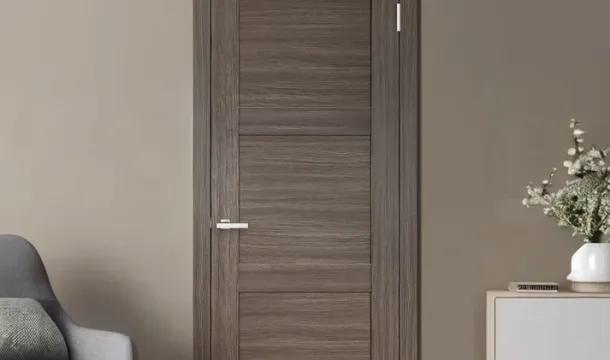How to Measure Interior Doors for Accurate Replacement
Popular Articles
Start by recording the jamb width at multiple points using calipers to confirm consistent depth along the frame. Uneven jambs may require custom adjustments or shimming during installation. Next, capture the full height from threshold to top jamb, ensuring measurements exclude any floor coverings that could alter final door placement.
Employ a reliable template or straightedge when outlining door dimensions on replacement material, prioritizing accurate width and depth values over nominal sizing. Overlooking slight discrepancies in these parameters often leads to binding or gaps post-installation.
Don?€(TM)t forget to assess the threshold thickness and verify its levelness; this affects door clearance and swing dynamics significantly. Recording all data in millimeters increases precision, especially when coordinating with suppliers who offer metric specifications.
Measure Door Width Precisely
Begin by removing any obstructions around the jamb and threshold to access the full frame depth. Use a reliable caliper or a steel tape measure to capture the exact width between the inside edges of the door frame. Measure at three distinct points: top, middle, and bottom. This ensures you account for any irregularities in the frame?€(TM)s alignment or warping.
Record each dimension carefully; the narrowest measurement dictates the ideal replacement width to prevent binding. Avoid including trim or molding in your calculations?€"focus strictly on the clear opening between jambs. When possible, use a custom template shaped to match the door?€(TM)s footprint, which can help visualize fit before ordering.
Pay special attention to threshold height and its impact on clearance. In cases where thresholds are raised or uneven, factor that into your width assessment since it affects how the door swings and seals. If the frame exhibits significant depth variation, note these details as they influence hinge placement and overall installation accuracy.
Determine Door Height Correctly
Use calipers or a reliable tape to capture the vertical dimension from the floor to the top edge of the door frame jamb. Avoid measuring just the door panel itself, as variations in frame height and depth can affect fit. Take multiple measurements at several points along the jamb?€"left, center, and right?€"to identify any irregularities caused by settling or installation shifts.
Employing a height template can streamline this process: position it flush against the jamb and mark consistent reference points for accurate comparison. Ensure that measurement includes any threshold or flooring thickness that may impact clearance.
Record both the total height and note the jamb?€(TM)s depth since thicker frames might require adjusted sizing beyond standard dimensions. Confirm that width and height dimensions correspond with each other to maintain proportional alignment when ordering a replacement unit. Precise vertical measurement prevents common issues such as binding or gaps after installation.
Check Door Thickness Dimensions
Accurate depth measurement is critical when selecting a new panel to fit seamlessly within the jamb and threshold. Most standard frames accommodate doors ranging from 1 3/8 inches (35 mm) to 1 3/4 inches (45 mm) thick, but older homes or custom installations may vary significantly. Use calipers or a precise ruler to gauge thickness at multiple points along the edge, ensuring consistent dimensions without warping or swelling.
Verify that the door?€(TM)s thickness aligns with the frame depth to avoid gaps or binding during operation. If the threshold includes weatherstripping or an adjustable sill plate, factor in these additions as they can slightly reduce clearance. Recording this dimension alongside width and height guarantees compatibility with existing hardware and smooth functionality within the doorway assembly.
Record Hinge Placement Details
Accurately documenting hinge location is critical to ensuring the new door fits seamlessly within the jamb and frame. Use calipers or a precise ruler to capture the exact width, depth, and height of each hinge cutout on the existing door.
- Distance from Top Edge: Measure from the upper edge of the door down to the top of each hinge leaf. This vertical dimension is essential for replicating positioning.
- Width and Depth of Mortise: Using calipers, record the width (side-to-side) and depth (front-to-back) of the hinge recesses in the door edge. This ensures proper hinge fit without gaps or misalignment.
- Spacing Between Hinges: Note the exact distance separating each hinge centerline along the door?€(TM)s height; consistency here supports balanced weight distribution.
- Jamb Frame Clearance: Measure how far each hinge extends into the jamb, verifying that clearance allows for smooth operation without binding against the frame.
If possible, create a template by tracing hinge outlines onto cardboard or paper at their precise placements. This visual aid simplifies transferring measurements during installation and helps verify dimensions before final cuts.
Documenting these specifics alongside width and height dimensions maintains uniformity across replacement components and prevents issues such as uneven swings or improper sealing once installed.
Measure Door Frame Opening
Begin by assessing the jamb-to-jamb width at three points: top, middle, and bottom. Use calipers or a reliable tape measure to capture each width dimension accurately, noting the smallest value to ensure the new door fits without forcing. Verify the height of the frame opening from the threshold to the underside of the header in multiple spots to detect any irregularities.
Depth is equally critical; measure from the interior wall surface out to where the jamb meets it, confirming sufficient clearance for the door slab and casing. Create a simple template of these dimensions on cardboard for visual reference and to cross-check during installation.
Inspect the frame for any warping or misalignment that could affect fitting. Accurate recording of all frame dimensions allows for precise customization, reducing adjustments during replacement and ensuring smooth operation after installation.
Popular Articles

Soundproofing Interior Doors: Which Options Are Best for Your Home?

Choosing the Perfect Interior Doors for Your Canadian Home
